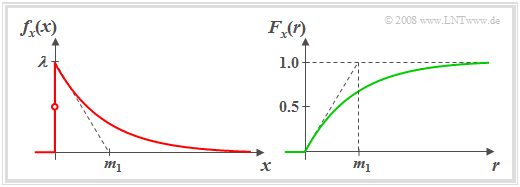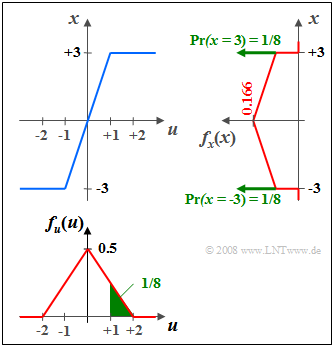Contents
One-sided exponential distribution
$\text{Definition:}$ A continuous random variable $x$ is called (one-sided) exponentially distributed if it can take only non–negative values and the PDF for $x>0$ has the following shape:
- $$f_x(x)=\it \lambda\cdot\rm e^{\it -\lambda \hspace{0.05cm}\cdot \hspace{0.03cm} x}.$$
The left sketch shows the "probability density function" $\rm (PDF)$ of such an exponentially distributed random variable $x$. Highlight:
- The larger the distribution parameter $λ$ is, the steeper the decay occurs.
- By definition $f_{x}(0) = λ/2$, i.e. the mean of left-hand limit $(0)$ and right-hand limit $(\lambda)$.
For the "cumulative distribution function" $\rm (CDF)$, we obtain for $r > 0$ by integration over the PDF (right graph):
- $$F_{x}(r)=1-\rm e^{\it -\lambda\hspace{0.05cm}\cdot \hspace{0.03cm} r}.$$
The "moments" of the one-sided exponential distribution are generally equal to
- $$m_k = k!/λ^k.$$
From this and from Steiner's theorem,nbsp; we get for the "mean"nbsp; and thenbsp; "rms value" (ornbsp; "standard deviation"):
- $$m_1={1}/{\lambda},$$
- $$\sigma=\sqrt{m_2-m_1^2}=\sqrt{\frac{2}{\lambda^2}-\frac{1}{\lambda^2}}={1}/{\lambda}.$$
$\text{Example 1:}$ The exponential distribution has great importance for reliability studies, and the term "lifetime distribution" is also commonly used in this context.
- In these applications, the random variable is often the time $t$ that elapses before a component fails.
- Furthermore, it should be noted that the exponential distribution is closely related to the Poisson distribution.
Transformation of random variables
To generate such an exponentially distributed random variable on a digital computer, you can use e.g. a nonlinear transformation. The underlying principle is first stated here in general terms.
$\text{Procedure:}$ If a continuous valued random variable $u$ possesses the PDF $f_{u}(u)$, then the probability density function of the random variable transformed at the nonlinear characteristic $x = g(u)$ holds:
- $$f_{x}(x)=\frac{f_u(u)}{\mid g\hspace{0.05cm}'(u)\mid}\Bigg \vert_{\hspace{0.1cm} u=h(x)}.$$
Here, $g\hspace{0.05cm}'(u)$ denotes the derivative of the characteristic curve $g(u)$ and $h(x)$ gives the inverse function to $g(u)$ .
- However, the above equation is only valid under the condition that the derivative $g\hspace{0.03cm}'(u) \ne 0$.
- For a characteristic with horizontal sections $(g\hspace{0.05cm}'(u) = 0)$: Additional Dirac delta functions appear in the PDF if the input variable has components in these ranges.
- The weights of these Dirac functions are equal to the probabilities that the input variable lies in these ranges.
$\text{Example 2:}$ Given a random variable $u$ triangularly distributed between $-2$ and $+2$ on a nonlinearity with characteristic $x = g(u)$,
- which, in the range $\vert u \vert ≤ 1$ triples the input values, and
- mapping all values $\vert u \vert > 1$ to $x = \pm 3$ depending on the sign,
then the PDF $f_{x}(x)$ sketched on the right is obtained.
Please note:
- Due to the amplification by a factor of $3$ ⇒ $f_{x}(x)$ is wider and lower than $f_{u}(u)$ by this factor.
- The two horizontal limits of the characteristic at $u = ±1$ lead to two Dirac delta functions at $x = ±3$, each with weight $1/8$.
- The weight $1/8$ corresponds to the green areas in the PDF $f_{u}(u).$
Generation of an exponentially distributed random variable
$\text{Procedure:}$ Now we assume that the random variable $u$ to be transformed is uniformly distributed between $0$ (inclusive) and $1$ (exclusive).
- Moreover, we consider the monotonically increasing characteristic curve
- $$x=g_1(u) =\frac{1}{\lambda}\cdot \rm ln \ (\frac{1}{1-\it u}).$$
- It can be shown that by this characteristic $x=g_1(u)$ a one-sided exponentially distributed random variable $x$ with the following PDF arises
(derivation see next page):
- $$f_{x}(x)=\lambda\cdot\rm e^{\it -\lambda \hspace{0.05cm}\cdot \hspace{0.03cm} x}\hspace{0.2cm}{\rm for}\hspace{0.2cm} {\it x}>0.$$
- Note:
- For $x = 0$ the PDF value is half $(\lambda/2)$.
- Negative $x$ values do not occur because for $0 ≤ u < 1$ the argument of the (natural) logarithm function does not become smaller than $1$.
By the way, the same PDF is obtained with the monotonically decreasing characteristic curve
- $$x=g_2(u)=\frac{1}{\lambda}\cdot \rm ln \ (\frac{1}{\it u})=-\frac{1}{\lambda}\cdot \rm ln(\it u \rm ).$$
Please note:
- When using a computer implementation corresponding to the first transformation characteristic $x=g_1(u)$ ⇒ the value $u = 1$ must be excluded.
- On the other hand, if one uses the second transformation characteristic $x=g_2(u)$ ⇒ the value $u =0$ must be excluded.
The following (German language) learning video shall clarify the transformations derived here:
"Erzeugung einer Exponentialverteilung" $\Rightarrow$ "Generation of an exponential distribution".
Derivation of the corresponding transformation characteristic
$\text{Exercise:}$ Now derive the transformation characteristic $x = g_1(u)= g(u)$ already used on the last page, which is derived from a random variable equally distributed between $0$ and $1$ ; $u$ with the probability density function (PDF) $f_{u}(u)$ forms a one-sided exponentially distributed random variable $x$ with the PDF $f_{x}(x)$ :
- $$f_{u}(u)= \left\{ \begin{array}{*{2}{c} } 1 & \rm if\hspace{0.3cm} 0 < {\it u} < 1,\\ 0.5 & \rm if\hspace{0.3cm} {\it u} = 0, {\it u} = 1,\ 0 & \rm else, \end{array} \right. \hspace{0.5cm}\rightarrow \hspace{0.5cm} f_{x}(x)= \left\{ \begin{array}{*{2}{c} } \lambda\cdot\rm e^{\it -\lambda\hspace{0.03cm} \cdot \hspace{0.03cm} x} & \rm if\hspace{0.3cm} {\it x} > 0,\ \lambda/2 & \rm if\hspace{0.3cm} {\it x} = 0 ,\ 0 & \rm if\hspace{0.3cm} {\it x} < 0. \ \end{array} \right.$$
$\text{Solution:}$
(1) Starting from the general transformation equation.
- $$f_{x}(x)=\frac{f_{u}(u)}{\mid g\hspace{0.05cm}'(u) \mid }\Bigg \vert _{\hspace{0.1cm} u=h(x)}$$
is obtained by converting and substituting the given PDF $f_{ x}(x):$
- $$\mid g\hspace{0.05cm}'(u)\mid\hspace{0.1cm}=\frac{f_{u}(u)}{f_{x}(x)}\Bigg \vert _{\hspace{0.1cm} x=g(u)}= {1}/{\lambda} \cdot {\rm e}^{\lambda \hspace{0.05cm}\cdot \hspace{0.05cm}g(u)}.$$
Here $x = g\hspace{0.05cm}'(u)$ gives the derivative of the characteristic curve, which we assume to be monotonically increasing.
(2) With this assumption we get $\vert g\hspace{0.05cm}'(u)\vert = g\hspace{0.05cm}'(u) = {\rm d}x/{\rm d}u$ and the differential equation ${\rm d}u = \lambda\ \cdot {\rm e}^{-\lambda \hspace{0.05cm}\cdot \hspace{0.05cm} x}\, {\rm d}x$ with solution $u = K - {\rm e}^{-\lambda \hspace{0.05cm}\cdot \hspace{0.05cm} x}.$
(3) From the condition that the input variable $u =0$ should lead to the output value $x =0$ , we obtain for the constant $K =1$ and thus $u = 1- {\rm e}^{-\lambda \hspace{0.05cm}\cdot \hspace{0.05cm} x}.$
(4) Solving this equation for $x$ yields the equation given in front:
- $$x = g_1(u)= \frac{1}{\lambda} \cdot {\rm ln} \left(\frac{1}{1 - u} \right) .$$
- In a computer implementation, however, ensure that the critical value $1$ is excluded for the equally distributed input variable $u$
- This, however, has (almost) no effect on the final result.
Two-sided exponential distribution - Laplace distribution
Closely related to the exponential distribution is the so-called Laplace distrubtion with the probability density function
- $$f_{x}(x)=\frac{\lambda}{2}\cdot\rm e^{\it -\lambda \hspace{0.05cm} \cdot \hspace{0.05cm} | x|}.$$
The Laplace distribution is a two-sided exponential distribution that approximates sufficiently well, in particular, the amplitude distribution of speech– and music signals.
- The moments $k$–th order ⇒ $m_k$ of the Laplace distribution agree with those of the exponential distribution for even $k$ .
- For odd $k$ on the other hand, the (symmetric) Laplace distribution always yields $m_k= 0$.
For generation one uses a between $±1$ equally distributed random variable $v$ (where $v = 0$ must be excluded) and the transformation characteristic curve
- $$x=\frac{{\rm sign}(v)}{\lambda}\cdot \rm ln(\it v \rm ).$$
Further notes:
- From the Exercise 3.8 one can see further properties of the Laplace distribution.
- In the (German) learning video Wahrscheinlichkeit und WDF $\Rightarrow$ Probability and PDF, it is shown which meaning the Laplace distribution has for the description of speech– and music signals.
- With the applet PDF, CDF and Moments you can display the characteristics $($PDF, CDF, Moments$)$ of exponential and Laplace distributions.
- We also refer you to the applet Two-dimensional Laplace random quantities .
Exercises for the chapter
Exercise 3.8: Amplification and Limitation
Exercise 3.8Z: Circle (Ring) Area
Exercise 3.9: Characteristic Curve for Cosine PDF
Exercise 3.9Z: Sine Transformation

